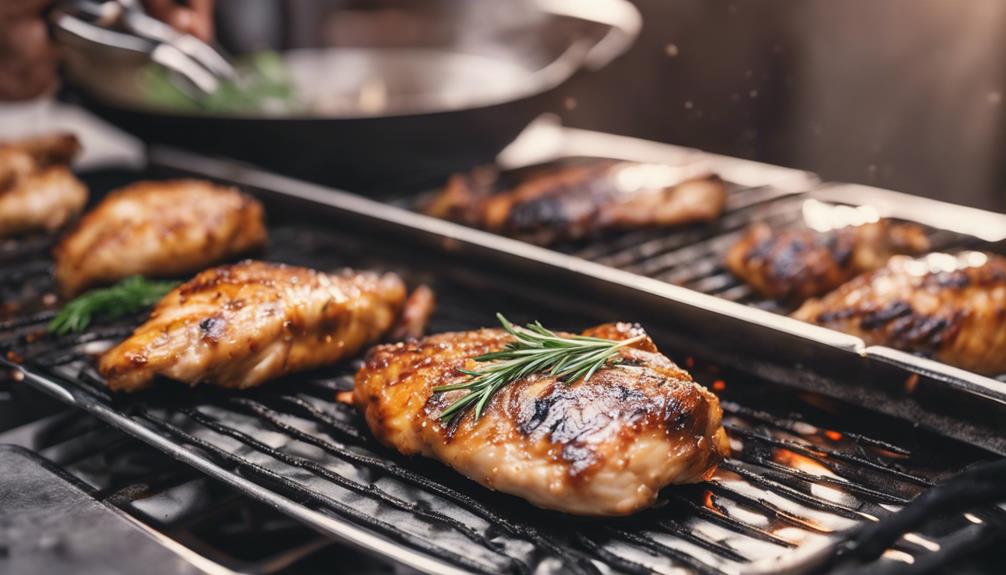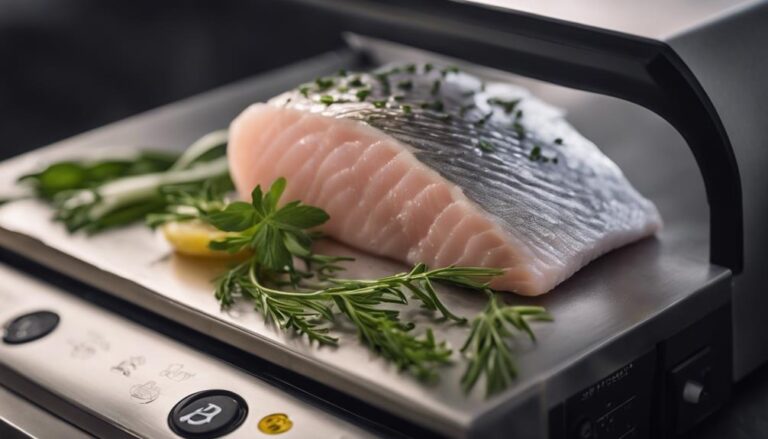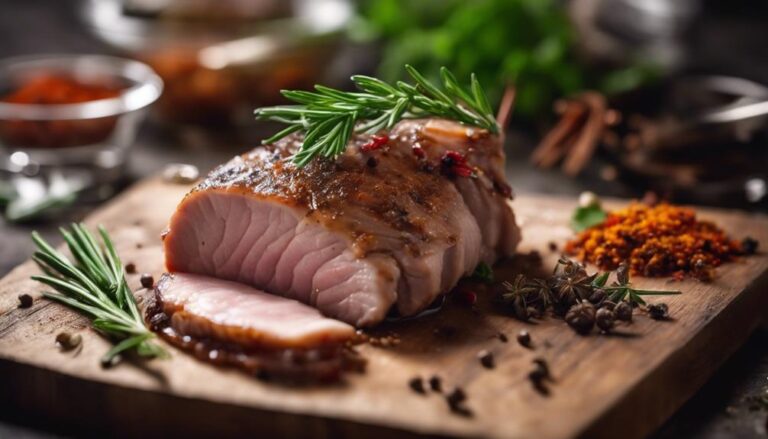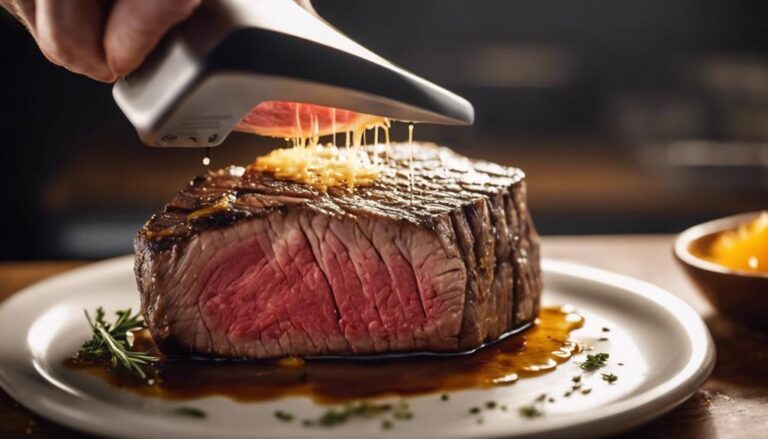Ultimate Guide: Chicken Breast Temp and Time Chart
To cook perfect chicken breast, aim for an internal temp of 165°F. Boneless breasts require careful monitoring, ensuring thickest part hits this temperature. Instant-read thermometer grants accuracy. Sous vide at 140°F for 1.5-4 hours for tenderness, 150°F for firmer texture. Breaking down connective tissue equals juicy chicken. Safety calls for 165°F-175°F for bone-in, check near the bone. Thaw frozen chicken completely before cooking. For bone-in, crucial and thorough cooking essential for safety and flavor. Get ready to dial in your chicken skills with these temperature and time guidelines.
What You Will Learn Here
- Sous vide chicken breast at 140°F for 1.5-4 hours for tenderness.
- Ensure boneless chicken reaches 165°F internally for safety and succulence.
- Thickest part of the breast must reach 165°F for even cooking.
- Use an instant-read thermometer for accurate internal temperature measurement.
- Cooking bone-in chicken requires longer time and thorough cooking to ensure safe consumption.
Importance of Sous Vide Chicken Temp
Understanding the sous vide chicken temperature is essential for achieving perfectly cooked poultry every time. When cooking chicken sous vide, the internal temperature is vital. Using a food thermometer to monitor the temperature guarantees that the chicken reaches the safe minimum internal temperature for consumption, which is 165°F.
This temperature is particularly significant for chicken breast meat, as it assures both safety and succulence in the results every time you cook. Sous vide cooking provides a precise and controlled environment that eliminates the guesswork often associated with traditional cooking methods.
Recommended Temperatures for Boneless Chicken
To ensure safe consumption and optimal juiciness, boneless chicken breasts should be cooked to an internal temperature of 165°F (74°C).
Ensuring that the thickest part of the chicken breast reaches this temperature is vital for food safety, as it helps eliminate harmful bacteria such as Salmonella. Using an instant-read thermometer is essential to accurately measure the internal temperature of the entire chicken breast.
Cooking the meat to 165°F (74°C) not only enhances safety but also helps maintain the desired juiciness and tenderness of the cooked breast. Remember to insert the thermometer into the thickest part of the chicken breast to get an accurate reading.
It typically takes about 20-30 minutes to reach the recommended internal temperature, depending on the thickness of the meat. Following these guidelines for boneless chicken breasts is essential to ensuring a delicious and safe meal for you and your guests.
Sous Vide Time Chart for Chicken
For ideal tenderness and consistent results when cooking chicken sous vide, refer to the sous vide time chart for precise cooking times. Cooking sous vide chicken at 140°F (60°C) for 1.5 to 4 hours yields a tender texture, guaranteeing the chicken is perfectly cooked throughout.
Sous vide cooking offers precise temperature control, resulting in uniform cooking every time. If you prefer a slightly firmer texture, try cooking your chicken at 150°F (65.6°C) for 1 to 4 hours.
The sous vide time chart is a valuable tool to help you determine the ideal cooking times for your chicken breasts. By following the recommended cooking times and temperatures, you can break down the connective tissue in the meat, achieving tender and juicy chicken.
Remember that there's carry over cooking, so use a thermometer to verify the internal temperature of the cooked chicken reaches the desired level for safe consumption.
Safety Guidelines for Cooking Chicken
If you've been following the sous vide time chart for chicken, now let's make sure you're aware of the safety guidelines for cooking chicken. Ensuring that chicken breasts reach an internal temperature of 165°F – 175°F is essential for making sure your meal is safe to eat.
To accurately measure the temperature, use a food thermometer and check the thickest part of the chicken. This is especially important for bone-in chicken, which requires longer cooking times to cook through properly. Different cooking methods like grilling, pan-cooking, and sous vide all necessitate reaching 165°F – 175°F for the chicken to be safe to eat.
Remember to thaw frozen chicken completely before cooking to avoid uneven cooking and ensure that your meal isn't only delicious but also safe. Prioritize food safety by always using an instant-read thermometer and following these guidelines for preparing chicken dishes.
Perfecting Bone-In Chicken Cooking Time
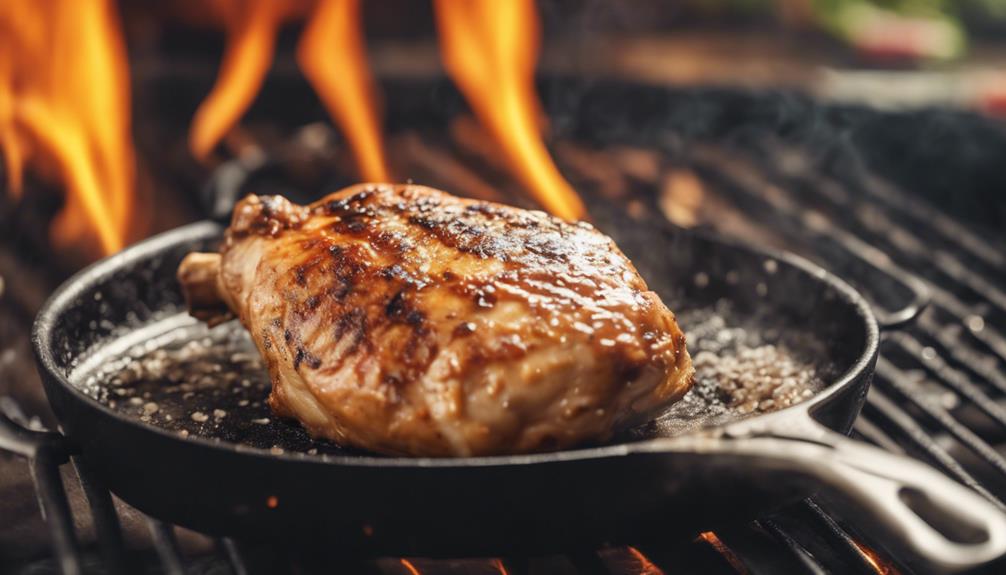
Mastering the art of cooking bone-in chicken requires precision and attention to detail. When dealing with bone-in chicken, especially the thickest cuts like drumsticks or thighs, it's important to guarantee thorough cooking to reach a safe internal temperature.
The bone acts as a conductor of heat, affecting the cooking time and temperature distribution in both dark and white meat portions. To make certain that your bone-in chicken is safe to eat, use a meat thermometer to check the internal temperature, especially near the bone.
Dark meat generally requires a longer cooking time than white meat due to its higher fat content and density. By following recommended cooking times and making sure that the internal temperature reaches 165°F, you not only perfect the flavor and texture of your bone-in chicken but also prioritize food safety for those you're serving.
Frequently Asked Questions
What Temperature and Length of Time to Cook Chicken Breast?
For tender chicken breast, cook at 165°F for 20-30 minutes. Use a meat thermometer to guarantee safety. Thicker cuts need more time. Resting helps maintain juices. Experiment with sous vide, grilling, marinades, poaching, brining, slow cooker, air frying, broiling, and pan-searing.
Is It Better to Bake Chicken at 350 or 400?
For juicy results and crispy skin, baking chicken at 400°F gives a golden brown crust. If you prefer a forgiving cooking process, opt for 350°F. The choice depends on your desired texture and cook time.
Is Chicken Done at 165 or 180?
When cooking chicken, aim for 165°F for safety. Dark meat can go up to 175-180°F for tenderness. Remember, hitting the correct temperature is key. Adjust recipes, check your thermometer, and allow for resting time for juicy, tender chicken.
Is It Safe to Eat Chicken Breast at 145?
For food safety, cooking chicken breast to 145°F is safe if you maintain it at that temperature for at least 8.5 minutes. This method, known as pasteurization, guarantees bacterial elimination while preserving preferred doneness, flavor, and texture.
Conclusion
To sum up, using the appropriate temperature and cooking time is essential for achieving perfectly cooked chicken breasts.
By following the suggested guidelines and safety precautions, you can guarantee that your chicken is juicy, tender, and safe to eat.
Experiment with different sous vide temperatures and times to discover the ideal combination that fits your taste preferences.
Happy cooking!
